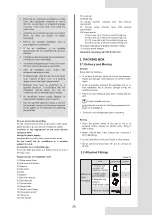
32
Please be careful to avoid the components
while connecting to the connecting pipes.
Low temperature solder alloys, such as
lead/tin alloys, are not acceptable for pipe
connections or any other refrigerant pressure
containing purposes.
Vacuum before welding, if necessary, to
ensure that there is no R32 residue in the
piping.
Oxygen free nitrogen (OFN) shall be purged
through the system both before and during
the brazing process.
CAUTION
The indoor and outdoor connecting pipe interface and
power line outlet.
Various piping and wiring patterns can be selected, such
as exiting from the front, the back, the side, and
undersurface, etc.
(The following displays the locations of several piping
and wiring knock-off interfaces)
The connection method of flaring
(18kW)
Back out
pipe
Side out
pipe
Front out
pipe
Bottom out
pipe
Figure 5-2
Forward piping connection mode (18kW)
Figure 5-3
Figure 5-4
Figure 5-5
Gas side piping
(provided on site)
Gas side piping
(provided on site)
Gas side piping
(provided on site)
Liquid side piping
(provided on site)
Liquid side piping
(provided on site)
Liquid side piping
(provided on site)
Side outlet connection mode
Outlet piping connection mode
Liquid side
stop valve
Gas side
stop valve
Back outlet piping connection mode
Gas side piping
(provided on site)
Liquid side piping
(provided on site)
Side out pipe: please remove the L-shape metal
plate, otherwise wiring cannot be completed.
Back outlet pipe: please wipe off the piping
support rubber blanket beside the inner outlet
pipe cover of the machine while the pipe exits
from the back.
Front outlet pipe: cut the frontal hole of the
pipe-outlet plate. The method for the outlet
pipe is the same as the back outlet pipe.
Undersurface outlet pipe: the knock out
should from inside to outside, and then piping
and wiring should be fed through this. Make
sure that the fat connecting pipe exits
through the largest hole, otherwise the pipes
will rub together. Please do the moth proofing
for the created hole, to avoid pests from
entering into and destroying the components.
CAUTION
5.3 Refrigerant Piping Connection
Figure 5-6
















































